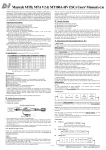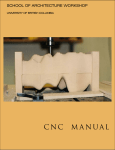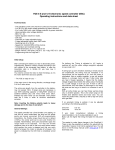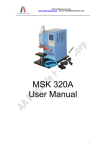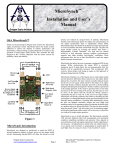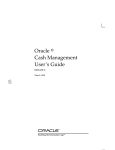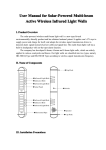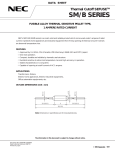Download MSHeli - ProgCard II
Transcript
MSHeli - ProgCard II - Programming Card With the programming card we offer you an easy to use programming unit which allows you to change every single function of our ProgCard II compatible ESC’s. A special feature is the exact cutoff voltage adjustment for the two Lithium batteries types on the market with their respective number of cells. Further can be adjusted the timing, different brake modes, the governor speed regulation and the accurate throttle stick positions by means of buttons. The actual settings can be read back with all our BEC ESC’s and our Optocoupler ESC’s from V4. All other Optocoupler ESC’s the setting can be seen only at programming time. A later read back is not possible because of the optical separation, also the power supply has to be provided by the patch cable. In addition to the LED matrix overview, the confirmation of the respective programming step is done via an acoustic signal, which is produced by the motor connected to the ESC. All this is possible without the otherwise usual stick programming. Operating instructions Disconnect the flight battery from the controller. Unplug the command cable from the receiver (or opto-coupler) and plug it into the left connector of the ProgCard II. The left contact is signal (white, yellow or orange), the center contact is +5V (red), and the right contact is minus (brown or black). If you inadvertently the plug the connector the wrong way, nothing happens, since the ProgCard II is protected against reversals. Connect now the flight pack to the ESC. On the progCard the upper LED of the lateral LED column will light. The ESC-Motor unit will signal 6 Beep (short melody) Shortly after that the current settings are read form the ESC as long as it is a BEC model. (Optocoupler ESC’s from V4 push Enter button now.) All LED will light up in a row. You are now on level 1, starting with the timing indicator. Now you choose with the lower left button the Menu selection and can see the programmed setting on the LED line. With the upper left button you can now choose a new value that will be actually programmed into the ESC with the Enter button on the right. The ESC will acknowledge with a positive beep. (The LED on the ProgCard II will turn off shortly and is followed by a low and a high tone beep.) Functions that cannot be programmed in the ESC are signaled with a negative beep. (1 low tone) All function can be adjusted like that, while the programming order is not relevant except for the Lipo type followed by the cutoff voltage adjustment and the cell count. Though, you can modify later on any single value anytime. 2 and 3 cells are recognized automatically by the controller. That is why the cell count settings are starting with 4 cells on the ProgCard II. The programming of the cell count is saved in the controller. Connecting a different cell count battery would lead to wrong under voltage detections. Setting again the Lipo type (LiPo / LiFe) will cancel the cell count and set the ESC again in automatic cell count detection! By activating the LiFe cell type (LiFePO4), the cutoff voltage is reduced by 0.7V per cell. Cutoff voltage (upper cutoff voltage line) for LiFe is 2.2 to 2.7V per cell. Cutoff voltage (lower cutoff voltage line) for LiPo is 2.9 to 3.4V per cell. In the NiMh mode, neither the cutoff voltage nor the cell count needs to be programmed. The slowdown is done automatically based on the battery voltage during connection. (Therefore, use only fully charged NiMh batteries) Beep short shortens the start beep. Rev. (Navy) Forward and reverse activation (only for Navy ESC). If a limitation is wanted for reverse, it has to be programmed in the transmitter. Stick position Brake off (without brake) For the throttle stick range calibration, please connect the enclosed extension cable from the receiver to the rightmost connector of the ProgCard II. Turn on the transmitter, and put the throttle on stop. Select the stop LED on the ProgCard II and push the Enter button. Do the same with the full power position and the Full Speed LED. Stick position Brake on (with brake) The brake starts 10% below the stop position, so the throttle stick range needs to be calibrated a bit shorter. For that put the throttle stick on 10% power ( about 3 notches away from stop) and proceed with the above calibration. Alternatively you can also learn in the complete stick range, after having set the servo travel from 10% to 100%. After calibration you need to come back to 0% - 100% to be able to reach the brake position. For transmitters with -100 to +100% servo travels you need to program -80°% to +100% for calibration and come back to -100, +100% after calibration. Brake smooth, middle, hard This three steps are only for folding air-screw! Acro special (F3A Brake) This function allows to adjust the F3A brake intensity without any step. You need again the extension cable, like described above, select the Acro Special LED, position the stick, e.g. for 50% brake on half throttle, and press the enter key. Likewise for 75%, put the stick on ¾ gas, etc. To program the ESCs with integrated opto-coupler you always need the extension cable like described above, as it is powering the ProgCard II through the receiver. To program an ESC with an additional external optocoupler, you have to remove the opto-coupler first. After calibration, the stop position in the transmitter needs to be lowered. That means that the lower servo travel of the throttle channel needs to be increased by 10% because the opto-coupler has a propagation delay of 50µs and thus the stop point is shifted. Level 2. All other functions like the governor mode can be accessed through the level 2 of the ProgCard by pushing briefly the two left buttons simultaneously. (the level switching occurs on release of the buttons) For confirmation the menu LED is blinking now. By pushing again the two left buttons you come back to level 1 exactly where you left level 1. Act. Freewheel (active Freewheel) allows best efficiency in the partial load range whereby the ESC remains clearly cooler. Governor Mode (Gov. / Gov. Store) For the use of the governor mode in a helicopter, the throttle stick range or the throttle curve (100%) must have been calibrated as described in level 1. A throttle curve point of e.g. 70% corresponds to a completely determined head speed, which is held as long as possible for the ESC due to the battery voltage. If the battery voltage drops below a certain level, even a full power setting won’t be able to reach the demanded head speed if the voltage doesn’t allow it. If this appears to be the case at the end of a flight, the throttle curve should be reduced accordingly. For both governor modes: don’t modify the P-gain, I-gain and PWM switching rate initially! If you do so the control loop parameters would also be modified. Governor Mode is the classical head speed regulation for helicopters. The setting of the throttle curve should be around 60 to 80% of the full throttle range. The controller learns at every start the correspondence of the throttle curve and the head speed. That is why there is a short head speed increase just before reaching the demanded speed. This can disturb the tail, but a slight pitching will settle things down as the helicopter is not „glued“ to the ground anymore. Gov. store is an extended helicopter feature, where the correspondence of the throttle curve and the head speed is done only at the first start (learning procedure). This head speed is stored so that at every later start the head speed will remain exactly the same. If you modify anything in the power system, you’ll have to select again the Gov store menu to perform a new learning. Proceeding: Place your throttle curve at the highest stage (e.g. 80%). Let then the ESC start and stay a while at the final reached head speed. A short rpm break down is to be normally noticed. Stop and switch off the battery from the ESC. At the next power up, start with the same or a lower throttle curve. If the learning wasn’t successful or wrong, you can reset the learning by selecting once again the Gov. Store. The learning can even be done with nearly or exactly 100%. Doing this will improve the correspondence of the throttle curve to the actual head speed. But please be careful as this 100% could lead to very high head speeds, and anyway don’t forget to set back the throttle curve to avoid flying with full power. fast (Gov.) can be selected along with both governor modes. This feature increases the control loop frequency and can be used above a magnetic pole commutation frequency of 80000 per minute. (poles/2 x motor rpm) To try only if the speed control is not completely satisfactory. The advantages are that the P and I gains can be reduced without getting a weak speed control. System resonances that are in the control loop bandwidth are not excited anymore. Important notice for the governor fine tuning. The governor software default parameters are adapted to most setups. Nevertheless, if necessary the following parameters (P and I gain) can be adjusted. P-Gain is the proportional gain. According to this parameter, head speed variations will be regulated harder or softer. Practically, it is the force of the control loop. (- weaker, + stronger). With smaller helis, less then 1m rotor diameter, this parameter shouldn’t exceed 1. With larger diameters you can go to the max. A bad adjustment is reflected by a wagging tail. I-Gain is the integral gain. According to this parameter, remaining head speed deviations are corrected faster or slower. It is an important complement to the P term: The P control is fast, but cannot recover completely the demanded head speed as it needs this deviation to exist. The I-term remembers this small remaining deviation and is able to remove it completely thanks to its „memory“. Both parameters should be adjusted simultaneously. If you can increase the P-term, you should generally also be able to increase the I term and vice versa. Too high settings can lead to a resonance between tail gyro and governor. The result is then a very noisy or even wagging tail that could lead to an out of control situation. Therefore the adjustments on P and I should be done in small steps. By selecting again one of the governor modes, these parameters are reset to their default values. Startup Speed is the spool up speed for helicopters and planes. PWM Frequency is the switching rate used for partial load operation. With low frequencies the losses are reduced, but the motors run slightly rougher. With high frequencies, it is the opposite. The optimum frequency may be found in the user manual of your motor. Startup Power. The higher the startup power, the faster and harder is the start. With small propellers it isn’t a problem, but with large ones, it can lead to a fairly rough startup behavior. Before you disconnect the progcard from the ESC, you can verify your programmed settings by scrolling through each menu line. But this is only a history of your recent settings and doesn’t reflect the other settings of the ESC. For that you have to read it in again. Hint: When you select a line where all LED’s are off (like the cell count lines) and push Enter, the ESC is really read back again. This is a way to control again the ESC settings without disconnecting the power. (Works only on BEC ESC’s) After programming, please disconnect first the flight battery and then reconnect the ESC plug into the receiver.









